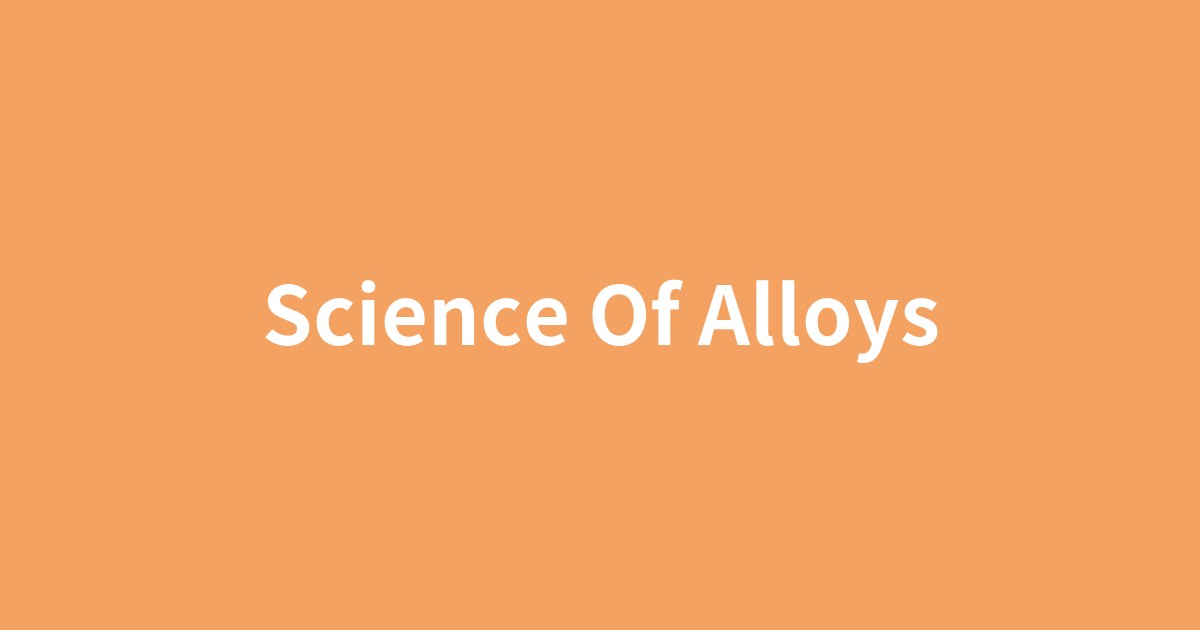このページは、歴史や文化の物語を楽しみながら、その文脈の中で重要な英単語を自然に学ぶための学習コンテンツです。各セクションの下にあるボタンで、いつでも日本語と英語を切り替えることができます。背景知識を日本語で学んだ後、英語の本文を読むことで、より深い理解と語彙力の向上を目指します。

鉄と炭素から鋼が、銅と錫から青銅が生まれるように、金属を混ぜ合わせることで、単体にはない優れた特性を持つ「合金」が生まれる仕組み。
この記事で抑えるべきポイント
- ✓合金とは、単一の金属元素に他の元素を添加することで、意図的に性質を改善した金属材料であるという基本的な概念。
- ✓合金が純金属より硬く強くなる主な理由は、大きさの異なる原子が混ざることで原子配列の規則性(結晶格子)が乱れ、原子の層が滑りにくくなる(転位が動きにくくなる)ためであるという科学的原理。
- ✓青銅器時代や鉄器時代に代表されるように、新しい合金の開発が人類の文明や技術を大きく飛躍させる原動力となってきた歴史的背景。
- ✓現代社会においても、航空宇宙産業の超合金や医療分野のチタン合金など、最先端技術は目的に特化した多様な合金によって支えられているという事実。
合金(Alloy)の科学 ― なぜ金属を混ぜると強くなるのか
私たちの手の中にあるスマートフォン、食卓に並ぶカトラリー。これらが純粋な金属だと思っていませんか?実はその多くが、複数の元素を混ぜ合わせて作られた「合金(Alloy)」です。しかし、なぜわざわざ金属を混ぜ合わせるのでしょうか。そして、混ぜることでなぜ硬く、強くなるのでしょう。この素朴な疑問から、原子レベルのミクロな世界、そして人類の文明史を巡る壮大な探求の旅を始めましょう。
The Science of Alloys: Why Do Metals Get Stronger When Mixed?
The smartphone in your hand, the cutlery on your dining table—do you think they are made of pure metal? In fact, many of them are "alloys," created by mixing multiple elements. But why go to the trouble of mixing metals? And why do they become harder and stronger as a result? Let's embark on a grand journey of discovery, from this simple question to the microscopic world of atoms and the history of human civilization.
「純粋」が常に最良とは限らない世界:合金とは何か
純粋な金は非常に美しく価値がありますが、同時にとても柔らかく、指輪や装飾品として使うには傷つきやすいという弱点があります。このように、単一の金属(metal)だけでは、実用面で限界がある場合があります。そこで人類が発見した知恵が、合金です。合金とは、ある金属に別の元素(element)を意図的に添加し、新たな特性を引き出した材料を指します。例えば、純粋な鉄は比較的もろいですが、そこに少量の炭素を加えることで、驚くほど強靭な「鋼(steel)」が生まれます。これは単なる混合物ではなく、それぞれの構成要素(component)が原子レベルで影響し合い、全く新しい性質を持つに至った「創造物」なのです。
A World Where "Pure" Isn't Always Best: What Is an Alloy?
Pure gold is beautiful and valuable, but it is also very soft and prone to scratching, making it less than ideal for rings and jewelry. Similarly, a single metal alone can have practical limitations. This is where humanity discovered the wisdom of alloys. An alloy is a material created by intentionally adding another element to a metal to give it new, improved properties. For example, pure iron is relatively brittle, but by adding a small amount of carbon, the incredibly tough material we know as steel is born. This is not just a simple mixture; it is a "creation" in which each component interacts at the atomic level to produce entirely new characteristics.
原子レベルで見る「強さ」の秘密:結晶格子の乱れ
では、なぜ合金は元の金属よりも優れた強度(strength)を持つのでしょうか。その秘密は原子の配列に隠されています。純金属の中では、原子は「結晶格子(Crystal lattice)」と呼ばれる非常に規則正しい構造で並んでいます。ここに外から力が加わると、原子の層が「転位(Dislocation)」というズレを伴って滑ることで、金属は変形します。この「滑りやすさ」が、純金属の柔らかさの原因です。一方、合金では、大きさの異なる原子が結晶格子に入り込みます。この「異物」が、まるで障害物のように転位の動きを妨げるのです。原子の層が滑りにくくなることで、結果として金属全体の硬度や強度が増す。これが、合金が強くなる基本的なメカニズムです。
The Secret to "Strength" at the Atomic Level: Disruption of the Crystal Lattice
So, why does an alloy possess greater strength than its original metal? The secret lies in the arrangement of atoms. In a pure metal, atoms are arranged in a very regular structure called a crystal lattice. When an external force is applied, the metal deforms as layers of atoms slide past one another, a process involving a defect known as a dislocation. This "ease of sliding" is the cause of a pure metal's softness. In an alloy, however, atoms of different sizes are introduced into the crystal lattice. These "foreign" atoms act as obstacles, impeding the movement of dislocations. By making it harder for the atomic layers to slide, the overall hardness and strength of the metal increase. This is the fundamental mechanism behind why alloys are stronger.
文明を築いた金属の進化:青銅から鉄へ
合金の発見は、人類の歴史そのものを大きく変えました。その最も象徴的な例が「青銅(bronze)」です。比較的柔らかい銅に錫を混ぜることで生まれたこの合金は、石器とは比べ物にならないほどの強度と加工性を誇りました。この画期的な材料の登場は、武器や農具、祭器に革命をもたらし、「青銅器時代」と呼ばれる新たな文明のステージを切り開いたのです。合金を自在に操る技術こそが、社会を発展させ、国力を左右する原動力でした。合金の進化の物語は、そのまま人類の文明の進化の物語でもあるのです。
The Evolution of Metals That Built Civilizations: From Bronze to Iron
The discovery of alloys profoundly changed the course of human history. The most iconic example is bronze. This alloy, created by mixing tin with relatively soft copper, boasted strength and workability far superior to stone tools. The advent of this revolutionary material brought about a revolution in weapons, farming tools, and ritual objects, ushering in a new stage of civilization known as the Bronze Age. The ability to master alloy technology was the driving force that developed societies and determined national power. The story of the evolution of alloys is, in itself, the story of the evolution of human civilization.
宇宙から体内まで:現代を支える最先端の合金
合金の科学は、古代の知恵にとどまらず、今なお進化を続けています。現代の最先端技術は、特定の目的のために精密に設計された多種多様な合金によって支えられています。例えば、航空機のジェットエンジンには、摂氏1000度を超える極限環境でも強度を保つ「超合金」が不可欠です。医療の現場では、人体へのなじみが良く、軽くて強いチタン合金が人工関節やインプラントとして活躍しています。私たちの身近なところでは、メガネのフレームに使われる形状記憶合金も、特定の温度で元の形に戻るという驚くべき性質を持った合金の一種です。これらはまさに、現代の錬金術が生み出した「スーパーマテリアル」と言えるでしょう。
From Space to Inside the Body: Advanced Alloys Supporting the Modern World
The science of alloys is not just ancient wisdom; it continues to evolve today. Modern cutting-edge technology is supported by a wide variety of alloys precisely designed for specific purposes. For instance, jet engines in aircraft rely on "superalloys" that maintain their strength in extreme environments exceeding 1000 degrees Celsius. In the medical field, titanium alloys, which are biocompatible, lightweight, and strong, are used for artificial joints and implants. Closer to home, the shape-memory alloys used in eyeglass frames are another type of alloy with the amazing property of returning to their original shape at a specific temperature. These are truly the "supermaterials" born from modern alchemy.
結論:混ぜ合わせる知恵が未来を創る
合金とは、異なる元素(element)の個性を巧みに組み合わせることで、単体では決して得られない優れた性質を生み出す「創造」の科学です。原子レベルのミクロな「乱れ」が、私たちの文明社会を支えるマクロな「強さ」という価値を生み出しているという事実は、非常に示唆に富んでいます。一つの純粋なものに固執するのではなく、異なるものを混ぜ合わせる知恵こそが、新たな可能性を切り開き、より豊かな未来を築いていくのかもしれません。私たちの世界は、まさにこの「混ぜ合わせる知恵」の上に成り立っているのです。
Conclusion: The Wisdom of Mixing Creates the Future
An alloy is the science of "creation," skillfully combining the characteristics of different elements to produce superior properties that could never be achieved by a single element alone. The fact that a microscopic "disorder" at the atomic level gives rise to the macroscopic "strength" that supports our civilized society is highly insightful. Perhaps it is not adherence to a single, pure substance, but the wisdom of mixing different things that opens up new possibilities and builds a richer future. Our world is, in essence, built upon this very "wisdom of mixing."
テーマを理解する重要単語
element
「合金」が複数の「元素」から成ることを説明する上で不可欠な単語です。この記事では、炭素や錫といった金属に添加される物質を指します。化学的な文脈だけでなく、「基本的な構成要素」という広い意味も持つため、様々な分野で応用が効く基礎語彙です。
文脈での用例:
Aristotle believed the world was composed of four basic elements: earth, water, air, and fire.
アリストテレスは世界が土、水、空気、火という4つの基本元素から構成されると信じていました。
component
合金を構成する各要素を指して使われています。elementが化学的な「元素」を指すのに対し、componentはより一般的にシステムや混合物の「構成要素」を指します。合金が単なる寄せ集めではなく、各要素が相互作用する「創造物」であることを理解する上で重要です。
文脈での用例:
The factory manufactures electronic components for computers.
その工場はコンピューターの電子部品を製造している。
strength
なぜ合金を作るのか、という問いへの最も直接的な答えがこの「強度」です。この記事では、物理的な頑丈さや壊れにくさを指しています。合金の存在意義そのものを示す中心的な概念であり、この単語のニュアンスを掴むことで、記事の核心に迫ることができます。
文脈での用例:
The new material is known for its exceptional strength and lightness.
その新素材は、並外れた強度と軽さで知られている。
property
この記事では、合金が持つ硬度や耐熱性といった「特性」を指す言葉として頻繁に使われます。単一の金属にはない、新たな「性質」を生み出すことが合金化の目的です。財産という意味も重要ですが、科学技術の文脈ではこの「特性」の意味で頻出するため、ぜひ覚えておきたい単語です。
文脈での用例:
This building is government property.
この建物は政府の所有物です。
adherence
記事の結論部分で、「一つの純粋なものへの固執(adherence to a single, pure substance)」という形で使われています。物理的な接着という意味もありますが、ここでは規則や信念を堅く守ることです。合金の科学から得られる教訓を、より普遍的な「混ぜ合わせる知恵」へと昇華させるための鍵となる概念です。
文脈での用例:
Strict adherence to the rules is required.
規則の厳格な順守が求められます。
insightful
「ミクロな乱れがマクロな強さを生むという事実は非常に示唆に富んでいる(highly insightful)」という文脈で使われています。物事の表面だけでなく、その本質を見抜いている様子を表す形容詞です。この記事が単なる科学知識の提供に留まらず、深い洞察を与えてくれるものであることを示唆しています。
文脈での用例:
She offered some insightful comments on our project.
彼女は私たちのプロジェクトについて、いくつか洞察に満ちたコメントをくれた。
profoundly
「合金の発見が人類の歴史を『深く』変えた」という文脈で使われ、その影響の大きさを強調しています。単に"very"や"greatly"と言うよりも、知的で、本質的なレベルでの変化を示す格調高い表現です。この記事の歴史的なスケールの大きさを感じ取るために重要な副詞です。
文脈での用例:
The experience profoundly changed my perspective on life.
その経験は私の人生観を深く変えました。
alloy
この記事の主題そのものである「合金」を指す最重要単語です。単なる混合物ではなく、意図的に特性を向上させた金属材料というニュアンスを掴むことが、記事全体の理解の鍵となります。動詞としての意味も知ることで、語彙の幅が広がります。
文脈での用例:
Bronze is an alloy of copper and tin.
青銅は銅と錫の合金です。
crystal lattice
合金がなぜ強くなるのか、その科学的メカニズムを理解するための鍵となる専門用語です。純金属内の原子が規則正しく並んだ構造を指します。この「整然とした構造」が、異なる原子によって「乱される」ことが強度向上の秘密である、という記事の論理展開を把握するために不可欠です。
文脈での用例:
In a pure metal, atoms are arranged in a regular crystal lattice.
純金属の中では、原子は規則正しい結晶格子状に並んでいる。
dislocation
「結晶格子」とセットで理解すべき科学用語で、原子の層がズレる現象を指します。この「転位」の動きやすさが金属の柔らかさの原因であり、合金内の異物原子がこの動きを妨げることで強度が増します。記事の科学的解説の核心部分を理解するために必須の単語です。
文脈での用例:
The movement of dislocations allows metals to be malleable.
転位の動きによって、金属は可鍛性を持つことができる。
brittle
合金化される前の純鉄の性質を「比較的もろい(relatively brittle)」と表現するために使われています。硬いが衝撃に弱い、ガラスのような壊れやすさを指す形容詞です。合金がなぜ必要とされるのか、元の金属が持つ弱点を具体的に理解する上で重要な単語です。
文脈での用例:
Old bones become brittle and are more likely to break.
古い骨はもろくなり、折れやすくなる。
superalloy
現代の最先端合金の代表例として登場します。摂氏1000度を超えるような極限環境でも強度を保つ高性能合金を指します。古代の青銅から現代の宇宙開発まで、合金技術がいかに進化してきたかを示す象徴的な単語であり、記事の壮大な物語性を補強しています。
文脈での用例:
Jet engine turbine blades are made from nickel-based superalloys.
ジェットエンジンのタービンブレードはニッケル基の超合金から作られている。
biocompatible
医療分野で使われるチタン合金の重要な特性を説明する単語です。人体に入れても拒絶反応を起こしにくい「生体適合性」を意味します。合金の応用範囲が、工業製品だけでなく人間の体内という特殊な環境にまで及んでいることを示しており、現代合金の多様性を理解する上で面白い単語です。
文脈での用例:
Titanium is a biocompatible metal used in medical implants.
チタンは医療用インプラントに使われる生体適合性のある金属です。